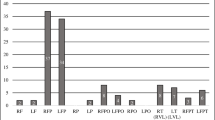Abstract
Introduction
Susceptibility-weighted imaging (SWI) visualizes even small cerebral veins and might, therefore, be valuable in monitoring neurological diseases affecting cerebral veins. Since it is generally difficult to evaluate individual results of quantitative MRI measurements, an automatic approach would be highly appreciated to assist the diagnostic process. The aim of this study was to evaluate the rescan and reanalysis reliability using an automatic venous volumetric approach based on SWI in healthy controls.
Methods
SWI was performed in ten healthy controls undergoing MRI examinations using a 32-channel head coil at 3 T five times on five different days. To test for rescan and reanalysis variability, the deep cerebral vein volume was quantified using ANTs and SPM8.
Results
Total volumes of cerebral deep veins measured during five MRI scans in ten individuals (n = 50 scans) showed intra-individual volume changes ranging from 0.07 to 1.03 ml (mean variability = 10.2 %). Automatic reanalyses revealed exactly the same results in all scans.
Conclusion
Automatic SWI-based cerebral vein volumetry shows acceptable rescan—and excellent reanalyses—reliability in healthy volunteers. Therefore, this approach might be beneficial in intra-individual follow-up studies of neurological diseases affecting the cerebral venous system.



Similar content being viewed by others
References
Ogawa S, Lee TM, Kay AR et al (1990) Brain magnetic resonance imaging with contrast dependent on blood oxygenation. Proc Natl Acad Sci U S A 87(24):9868–9872
Reichenbach JR, Barth M, Haacke EM et al (2000) High-resolution MR venography at 3.0 Tesla. J Comput Assist Tomogr 24(6):949–957
Haacke EM, Xu Y, Cheng YN et al (2004) Susceptibility weighted imaging (SWI). Magn Reson Med 52(3):612–618. doi:10.1002/mrm.20198
Reichenbach JR, Venkatesan R, Schillinger DJ et al (1997) Small vessels in the human brain: MR venography with deoxyhemoglobin as an intrinsic contrast agent. Radiology 204(1):272–277. doi:10.1148/radiology.204.1.9205259
Sehgal V, Delproposto Z, Haacke EM et al (2005) Clinical applications of neuroimaging with susceptibility-weighted imaging. J Magn Reson Imaging 22(4):439–450. doi:10.1002/jmri.20404
Thomas B, Somasundaram S, Thamburaj K et al (2008) Clinical applications of susceptibility weighted MR imaging of the brain—a pictorial review. Neuroradiology 50(2):105–116. doi:10.1007/s00234-007-0316-z
Tsui Y, Tsai FY, Hasso AN et al (2009) Susceptibility-weighted imaging for differential diagnosis of cerebral vascular pathology: a pictorial review. J Neurol Sci 287(1-2):7–16. doi:10.1016/j.jns.2009.08.064
Barnes SRS, Haacke EM (2009) Susceptibility-weighted imaging: clinical angiographic applications. Magn Reson Imaging Clin N Am 17(1):47–61. doi:10.1016/j.mric.2008.12.002
Luo S, Yang L, Wang L (2014) Comparison of susceptibility-weighted and perfusion-weighted magnetic resonance imaging in the detection of penumbra in acute ischemic stroke. J Neuroradiol. doi:10.1016/j.neurad.2014.07.002
Hermier M, Nighoghossian N (2004) Contribution of susceptibility-weighted imaging to acute stroke assessment. Stroke 35(8):1989–1994. doi:10.1161/01.STR.0000133341.74387.96
Mahvash M, Pechlivanis I, Charalampaki P et al (2014) Visualization of small veins with susceptibility-weighted imaging for stereotactic trajectory planning in deep brain stimulation. Clin Neurol Neurosurg 124:151–155. doi:10.1016/j.clineuro.2014.06.041
Xia X, Tan C (2013) A quantitative study of magnetic susceptibility-weighted imaging of deep cerebral veins. J Neuroradiol 40(5):355–359. doi:10.1016/j.neurad.2013.03.005
Fushimi Y, Miki Y, Mori N et al (2010) Signal changes in the brain on susceptibility-weighted imaging under reduced cerebral blood flow: a preliminary study. J Neuroimaging 20(3):255–259. doi:10.1111/j.1552-6569.2008.00348.x
Sedlacik J, Helm K, Rauscher A et al (2008) Investigations on the effect of caffeine on cerebral venous vessel contrast by using susceptibility-weighted imaging (SWI) at 1.5, 3 and 7 T. Neuroimage 40(1):11–18. doi:10.1016/j.neuroimage.2007.11.046
Chang K, Barnes S, Haacke EM et al (2014) Imaging the effects of oxygen saturation changes in voluntary apnea and hyperventilation on susceptibility-weighted imaging. AJNR Am J Neuroradiol 35(6):1091–1095. doi:10.3174/ajnr.A3818
Tustison NJ, Avants BB, Cook PA et al (2010) N4ITK: improved N3 bias correction. IEEE Trans Med Imaging 29(6):1310–1320. doi:10.1109/TMI.2010.2046908
Avants BB, Tustison NJ, Song G et al (2011) A reproducible evaluation of ANTs similarity metric performance in brain image registration. Neuroimage 54(3):2033–2044. doi:10.1016/j.neuroimage.2010.09.025
Bates D, Mächler M, Bolker B et al (2015) Fitting linear mixed-effects models using lme4. J Stat Softw 67(1):1–48. doi:10.18637/jss.v067.i01
Nowinski WL, Puspitasari F, Volkau I et al (2013) Quantification of the human cerebrovasculature: a 7 Tesla and 320-row CT in vivo study. J Comput Assist Tomogr 37(1):117–122. doi:10.1097/RCT.0b013e3182765906
Schaller B (2004) Physiology of cerebral venous blood flow: from experimental data in animals to normal function in humans. Brain Res Brain Res Rev 46(3):243–260. doi:10.1016/j.brainresrev.2004.04.005
Acosta-Cabronero J, Williams GB, Cardenas-Blanco A et al (2013) In vivo quantitative susceptibility mapping (QSM) in Alzheimer’s disease. PLoS ONE 8(11), e81093. doi:10.1371/journal.pone.0081093
Zheng W, Nichol H, Liu S et al (2013) Measuring iron in the brain using quantitative susceptibility mapping and X-ray fluorescence imaging. Neuroimage 78:68–74. doi:10.1016/j.neuroimage.2013.04.022
Einhäupl K, Stam J, Bousser M et al (2010) EFNS guideline on the treatment of cerebral venous and sinus thrombosis in adult patients. Eur J Neurol 17(10):1229–1235. doi:10.1111/j.1468-1331.2010.03011.x
Savoiardo M, Minati L, Farina L et al (2007) Spontaneous intracranial hypotension with deep brain swelling. Brain 130(Pt 7):1884–1893. doi:10.1093/brain/awm101
Mucke J, Möhlenbruch M, Kickingereder P et al (2015) Asymmetry of deep medullary veins on susceptibility weighted MRI in patients with acute MCA stroke is associated with poor outcome. PLoS ONE 10(4), e0120801. doi:10.1371/journal.pone.0120801
Author information
Authors and Affiliations
Corresponding author
Ethics declarations
We declare that this human study has been approved by the local ethics committee and has therefore been performed in accordance with the ethical standards laid down in the 1964 Declaration of Helsinki and its later amendments. We declare that all patients gave informed consent prior to inclusion in this study.
Conflict of interest
We declare that we have no conflict of interest.
Rights and permissions
About this article
Cite this article
Egger, K., Dempfle, A.K., Yang, S. et al. Reliability of cerebral vein volume quantification based on susceptibility-weighted imaging. Neuroradiology 58, 937–942 (2016). https://doi.org/10.1007/s00234-016-1712-z
Received:
Accepted:
Published:
Issue Date:
DOI: https://doi.org/10.1007/s00234-016-1712-z




